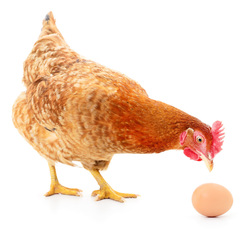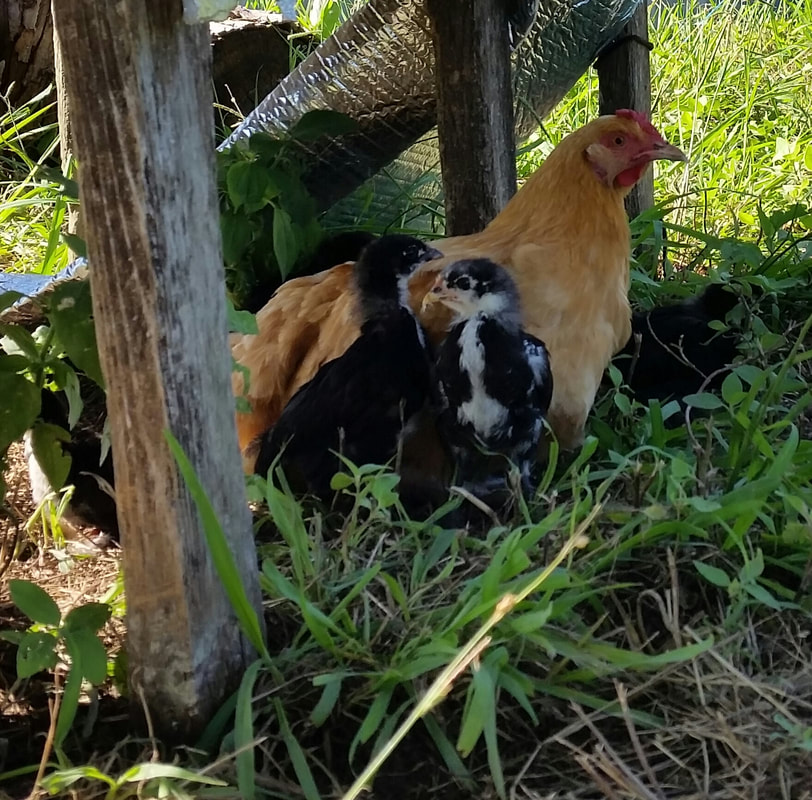0 Comments
The first three chicks emerge from under the golden feathers of mama hen. Being the good hen that she is, she's not going to let me get a look under her to see how many of the 15 eggs have hatched. This can wait for another day. As you can tell, the chicks are not yellow like Buff Orpington chicks should be. These three are Black Australorp chicks. Hoping there are some Orpingtons that hatched as well. I will keep you posted as more chicks should hatch under hen #2 this weekend. Please, post a photo of your chicks in the comments. Would love to see them!
 The color of an egg shell is determined by the pigments, or lack of, deposited as the egg develops. The pigments deposited are determined by genetics. All eggs start out as white. It takes 26 hours for an egg to travel down the hen's oviduct. It's during the last 20 hours that the shell is formed. For white eggs, no pigments are deposited on the egg during this process. For brown eggs, the pigment protoporphyrin is deposited on the egg late in the process. The brown does not penetrate the shell so the inside of the shell remains white. There are many shades of brown eggs. Some very light browns almost look pinkish. Blue and green eggs are formed when the pigment oocyanin is deposited eariler in the process and permeates the shell, resulting in an inner shell color that is also blue or green. So how do you know what color eggs a hen will lay? A good rule of thumb is to check the hen's ear lobe color. If it's white, she will lay white eggs. If it's red or brown, she will lay brown eggs. There are a few breeds with red ear lobes which are an exception to this rule. Then there are the Araucana and Ameraucana hens which lay the blue-green eggs. When a blue/green egg layer is crossed with a brown egg layer, the result is an olive color egg. These hens are called Olive Eggers. The blue shell develops with brown pigments added towards the end of development process. Another tidbit of information for you... An individual hen typically lays eggs of the same color and hue. Happy farming and God bless! Photo Copyright: <a href='http://www.123rf.com/profile_tsekhmister'>tsekhmister / 123RF Stock Photo</a>  Did you know that most other countries sell eggs that are not refrigerated? The US is one of the few oddballs when it comes to refrigerating eggs. Let me tell you about my personal experience and share some egg facts with you. Then you can decide what you are more comfortable with. Many years ago, while at a relative’s house, I noticed a large flats of eggs stored in the utility room. I wondered why they were not refrigerated. Sometime later while watching a cooking show, a famous chef stated that he preferred to cook with room temperature eggs. These two events got me to thinking. I did some research and discovered not everyone stores their eggs in a refrigerator. Before I go any further, let me give you some scientific information. Just before a hen lays an egg, she adds a protective covering to seal the egg. This is an antibacterial covering called bloom. The bloom prevents bacteria from entering the egg as well as keeping moisture inside the egg. Mother Nature is awesome! Here is something else you might not know. Commercial egg producers wash off the bloom before packing the eggs for sale to the public. Washing the bloom off the egg, particularly with cold water, causes the pores of the egg shell to pull in bacteria from the outer surface of the egg. When this is done, eggs must be immediately refrigerated to prevent bacteria, which may have entered, from growing and causing a food-borne illness that could lead to food poisoning. Knowing this, you should never remove eggs from the refrigerator and then store them at room temperature. The protective bloom is no longer on the egg. Therefore, the egg is NOT protected from bacteria entering and growing inside. So how do I store eggs if I do not refrigerate them? I store them at room temperature in a cool part of the kitchen. Here are some pointers... 1. Use only farm fresh eggs that you know have never been washed. 2. Do NOT wash the eggs. Most eggs are very clean when laid. If they are a little dusty or a feather attached, wipe them off with a dry cloth or paper towel. If they are dirty, wash them in water and store in the refrigerator. 3. With a pencil, write the date the egg was laid on the shell. When you get a large collection of eggs, this will make it easier to identify the oldest ones. The accountant in me always uses the FIFO (First In First Out) method when choosing a fresh egg for cooking. 4. At this point you can either place the eggs in a basket as pictured here, or place them fat end up in an egg carton. (In order of date laid, of course. wink) 5. Now comes the big question... How long can an egg be stored at room temperature? This question is almost as controversial as, "Which came first, the chicken or the egg?" All I can tell you is what I, and others I know, have done. I have eaten and used eggs that were stored on the counter for a couple of months. HOWEVER, I NEVER use them when they are more than a few of weeks old without doing the Float Test. See my blog from last week as it tells in detail how to do the Float Test. Just remember, if the egg floats, don't eat it. 6. When using eggs stored at room temperature, always make a few quick common sense checks first. 1) Float Test - make sure the egg sinks before using it. 2) If it smells bad, never use it! 3) A fresh egg whites are a cloudy white. Old eggs have clear egg whites. Spoiled eggs whites have a pinkish cloudy color. Do NOT use. I have followed these steps for years without any signs of contracting food poisoning. I hope you have found this information informative and useful. Now for the disclaimer.... The FDA recommends refrigerating eggs. Follow this link, http://www.fda.gov/food/resourcesforyou/Consumers/ucm077342.htm for more information. Please do your research on egg storage and follow the method you are most comfortable with. Cheers, and God Bless!  People are always asking me how the float test works in determining the freshness of an egg. To show how it works, I drew this simple diagram. Eggs that lay flat on the bottom are fresh. If the fat end is starting to stand up they are about a week old, and a few weeks old if they are standing on end. When doing this test, it is very possible you will see eggs floating somewhere between the standing on end and the floating above water stage. This just means the air-cell size is getting bigger in the egg. The bigger the air cell, the higher it will float, the older the egg will be. Another way to estimate the egg's age is to break it open and examine the contents. A fresh egg has a firm yolk standing high surrounded by an egg white with a cloudy firm appearance. As the egg ages, the egg white, or albumen, will becomes clear and watery and the yoke begins to flatten. The older the egg gets, the more likely it is the yolk will break when you crack open the shell. This happens because water moves from the albumen (egg white) to the yolk causing the yolk membrane to stretch and weaken. It eventually breaks. If you want still another way to test freshness, smell it! If it has a foul rotten-egg smell, it's bad! This smell results from the emission of hydrogen sulfide. |
A Mattingly
Artist, Writer, Holistic Living Guide Important Disclaimer: Any content discussing medicinal uses of plants, herbs, or food as medicine is informational only and not prescriptive. When dealing with health issues, be sure to do your own research and consult with the appropriate health professional for guidance. These statements have not been evaluated by the FDA. It is information based on my personal research and studies.
Categories
All
Archives
September 2023
|






 RSS Feed
RSS Feed